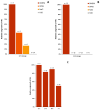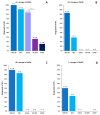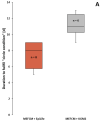Generating iPSCs with a High-Efficient, Non-Invasive Method-An Improved Way to Cultivate Keratinocytes from Plucked Hair for Reprogramming
- PMID: 35741085
- PMCID: PMC9222083
- DOI: 10.3390/cells11121955
Generating iPSCs with a High-Efficient, Non-Invasive Method-An Improved Way to Cultivate Keratinocytes from Plucked Hair for Reprogramming
Abstract
Various somatic cell types are suitable for induced pluripotency reprogramming, such as dermal fibroblasts, mesenchymal stem cells or hair keratinocytes. Harvesting primary epithelial keratinocytes from plucked human hair follicles (HFs) represents an easy and non-invasive alternative to a fibroblast culture from invasive skin biopsies. Nevertheless, to facilitate and simplify the process, which can be divided into three main steps (collecting, culturing and reprogramming), the whole procedure of generating hair keratinocytes has to be revised and upgraded continuously. In this study, we address advancements and approaches which improve the generation and handling of primary HF-derived keratinocytes tremendously, e.g., for iPSCs reprogramming. We not only evaluated different serum- and animal-origin-free media, but also supplements and coating solutions for an enhanced protocol. Here, we demonstrate the importance of speed and accuracy in the collecting step, as well as the choice of the right transportation medium. Our results lead to a more defined approach that further increases the reliability of downstream experiments and inter-laboratory reproducibility. These improvements will make it possible to obtain keratinocytes from plucked human hair for the generation of donor-specific iPSCs easier and more efficient than ever before, whilst preserving a non-invasive capability.
Keywords: hair follicle (HF); induced pluripotent stem cells (iPSCs); keratinocytes; plucked human hair.
Conflict of interest statement
The authors declare no conflict of interest.
Figures














Similar articles
-
Efficient Generation of Pancreatic Progenitor Cells from Induced Pluripotent Stem Cells Derived from a Non-Invasive and Accessible Tissue Source-The Plucked Hair Follicle.Cells. 2024 Jun 10;13(12):1010. doi: 10.3390/cells13121010. Cells. 2024. PMID: 38920642 Free PMC article.
-
Induced pluripotent stem cell line MUSIi006-A derived from hair follicle keratinocytes as a non-invasive somatic cell source.Stem Cell Res. 2018 Aug;31:79-82. doi: 10.1016/j.scr.2018.07.007. Epub 2018 Jul 19. Stem Cell Res. 2018. PMID: 30031234
-
Generation of Integration-free Human Induced Pluripotent Stem Cells Using Hair-derived Keratinocytes.J Vis Exp. 2015 Aug 20;(102):e53174. doi: 10.3791/53174. J Vis Exp. 2015. PMID: 26327431 Free PMC article.
-
A Comparative View on Human Somatic Cell Sources for iPSC Generation.Stem Cells Int. 2014;2014:768391. doi: 10.1155/2014/768391. Epub 2014 Nov 6. Stem Cells Int. 2014. PMID: 25431601 Free PMC article. Review.
-
An Overview on Promising Somatic Cell Sources Utilized for the Efficient Generation of Induced Pluripotent Stem Cells.Stem Cell Rev Rep. 2021 Dec;17(6):1954-1974. doi: 10.1007/s12015-021-10200-3. Epub 2021 Jun 7. Stem Cell Rev Rep. 2021. PMID: 34100193 Review.
Cited by
-
Spatial proteomics identifies JAKi as treatment for a lethal skin disease.Nature. 2024 Nov;635(8040):1001-1009. doi: 10.1038/s41586-024-08061-0. Epub 2024 Oct 16. Nature. 2024. PMID: 39415009 Free PMC article.
-
The impact of induced pluripotent stem cells in animal conservation.Vet Res Commun. 2024 Apr;48(2):649-663. doi: 10.1007/s11259-024-10294-3. Epub 2024 Jan 16. Vet Res Commun. 2024. PMID: 38228922 Review.
-
Bulge-Derived Epithelial Cells Isolated from Human Hair Follicles Using Enzymatic Digestion or Explants Result in Comparable Tissue-Engineered Skin.Int J Mol Sci. 2025 Feb 21;26(5):1852. doi: 10.3390/ijms26051852. Int J Mol Sci. 2025. PMID: 40076477 Free PMC article.
References
-
- Sobhani A., Khanlarkhani N., Baazm M., Mohammadzadeh F., Najafi A., Mehdinejadiani S., Aval F.S. Multipotent Stem Cell and Current Application. Acta Med. Iran. 2017;55:6–23. - PubMed
-
- Shafa M., Yang F., Fellner T., Rao M.S., Baghbaderani B.A. Human-Induced Pluripotent Stem Cells Manufactured Using a Current Good Manufacturing Practice-Compliant Process Differentiate Into Clinically Relevant Cells From Three Germ Layers. Front. Med. 2018;5:69. doi: 10.3389/fmed.2018.00069. - DOI - PMC - PubMed
Publication types
MeSH terms
LinkOut - more resources
Full Text Sources
Other Literature Sources
Research Materials
Miscellaneous

